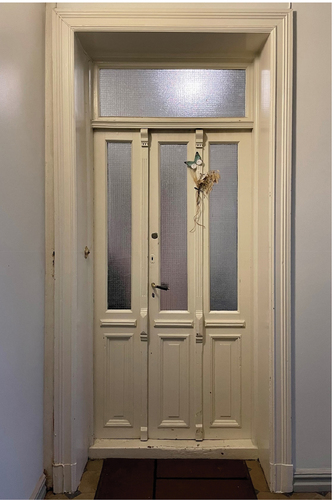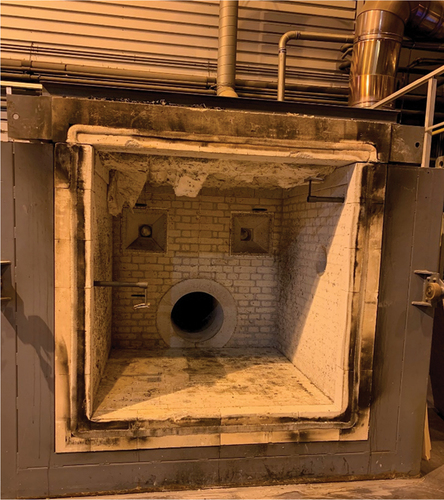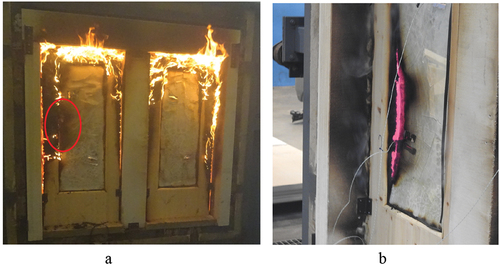ABSTRACT
Original timber stairwell doors in historic masonry apartment buildings of architectural heritage value can be found in the larger cities of Norway. In Oslo, there are around 4000 such buildings, of which many still hold preserved original stairwell doors. The doors often have glass with decorative patterns in the upper parts, and timber panels on the lower part. Old residential buildings are vulnerable to fire due to the building construction and need fire protection upgrades. The stairwell doors are critical elements to prevent fire spread and to keep evacuation routes safe, so their function and condition are important to the level of fire protection in the building. The research work in this paper aims to find retrofit methods for upgrading the fire resistance of these types of doors so they maintain their integrity and insulating properties for up to 30 minutes, at the same time as they maintain their architectural expression. The upgrades must be as little intrusive and destructive as possible. Intermediate scale tests were carried out in a fire resistance test furnace, using different door configurations. The tests lasted between 30 minutes and 42 minutes, with a thermal exposure from the standard time/temperature curve described in EN 1363–1. The results from the tests showed that 40 mm thick laminated wood could withstand up to 30 minutes of fire exposure, thin timber panels could be upgraded using stone wool and robust gypsum boards type R, and that fire-resistant glass could be mounted on the inside of the original glass in different ways. Visual observations indicate that adding smoke seals inside the door leaf are effective for stopping cold and hot smoke. The solutions presented enables the preservation of the original doors’ architectural design, their historical values and aesthetic character.
1. Introduction
Original timber panelled stairwell doors have architectural heritage value. Such doors are in common use in historic masonry residential buildings of architectural heritage value in the larger cities of Norway and in many other cities. The old masonry residential buildings have walls of load-bearing masonry, wooden beams and roof structures in wood, and many of them are categorised as architectural heritage. In Oslo, the capital of Norway, there are around 4000 such buildings, of which many still hold preserved original stairwell doors, and the largest cities in Norway, such as Trondheim, Bergen, and Ålesund also have many historic masonry residential buildings. In addition, Trondheim, Oslo and Bergen have several timber residential buildings with the same kind of doors (Oslo kommune Brann- og redningsetaten Citation2015). Because of their construction, the old residential buildings are vulnerable to fire. The buildings have floor dividers with timber beams and cavities in the construction. This increases the risk of rapid fire spreading in the building and the need for fire protection upgrading (Dyrseth Citation2014; Stenstad Citation1983). In residential buildings with only one stairwell, there will sometimes be a need for the upgrading of both the building fabric and fire technical measures to achieve an acceptable level of safety (Oslo kommune Brann- og redningsetaten Citation2015).
1.1. Typical build-up of original timber panelled stairwell doors
The original timber doors are highly crafted and ornate. Rich decorations and large glass panels against common areas make these doors a major element of the architectural appearance of the building (Oslo kommune Brann- og redningsetaten Citation2007). In the buildings that still have the original stairwell doors between apartments and stairwells, there are usually decorated wooden filling doors, with complex moulding profiles. The lower part of the door leaf has a timber panel, while the upper part of the door leaf is often fitted with glass panels. Many doors also have side panels and top panel with glass. See . The glass panels were originally made of cylinder glass, often with “acid-etched” decorative patterns (Wedvik Citation2018). Such glass had very poor fire resistance (Stenstad Citation1983). The traditional filling doors were often made of a solid pine wood frame holding an upper glass panel and a lower thinner wood panel. The frame parts were usually joined together with plugs or wedges. These types of doors normally have a thickness of 40–50 mm on the frame part and about 10 mm in the thinnest parts of the wood panel.
1.2. Upgrading of fire safety in buildings
Compromises are inevitable when architectural heritage values and fire safety requirements are to be reconciled. Establishing a modern fire alarm system will often be the simplest measure and least intrusive to increase the level of fire safety of the occupants of the building. External fire escape stairwells can be considered. However, since this means introducing a new architectonic element on the façade, it is rarely the first choice by the architectural heritage authorities. Also, an additional fire-rated door can be introduced inside the original apartment door if there is room for it (Korsaksel Citation2009).
The demand for upgrading arises when a need for risk mitigation or a higher fire safety level for a building is recognised. The stairwell doors are critical elements to prevent fire spread and to keep evacuation routes safe, so their function and condition are important to the level of fire protection in the building, and the upgrading of doors will often be part of a building’s fire safety upgrading plan. Increased requirements for fire safety mean that the preservation of such stairwell doors in historic residential buildings is under pressure, and many valuable original doors have already been replaced by new fire-rated doors. 30 minutes fire resistance (integrity and insulation) is the performance usually required for apartment doors to stairwells in pre-accepted solutions according to the Norwegian Building Regulations (Direktoratet for byggkvalitet Citation2017), and the same applies to the other Nordic countries. In the following, only intrusive solutions are discussed with the aim of increasing the function of the doors as a fire barrier. The main goal of this project is to help ensure that the invasive measures that are taken on the original doors change as little as possible of the original material, are as reversible as possible, and function satisfactorily as fire protection.
1.3. Retrofit upgrading of fire resistance to doors
Wood is a combustible material, and its behaviour when subjected to fire is burning and charring. The charring rate varies depending on type of wood, moisture content etc., but the design charring rate of solid wood is set to 0.65 mm/min (Standard Norge Citation2010). A 9 mm fielded panel would for instance with the same rate burn through after 14 minutes. Glass is an incombustible material; however, traditional glass has poor fire-resistance and will crack when subjected to high temperatures, most likely after a few minutes if there is a flashover in an apartment. Retrofitting methods are commonly used for building constructions, for instance chemical coating, fireproof paint, concrete coating, gypsum boards and firestop materials (plastic-based or cementitious) (Zahmatkesh and Memari Citation2017). A study on treatments and modification to improve the reaction to fire of wood showed that pure chemical modification of wood have little improvement on the reaction to fire of wood, and should be combined with the use of fire retardant chemicals (Popescu and Pfriem Citation2020). However, there is a lack of knowledge in the journal article literature when it comes to retrofit methods of upgrading of fire resistance to wooden doors in particular.
Different solutions have been presented in guidelines for upgrading of fire resistance to original timber doors. In Norway, the most important guidelines have been (SINTEF Citation2016) and a guideline made by Oslo municipality, which has been withdrawn (Oslo kommune ved Byantikvaren og Brann- og redningsetaten Citation2015). However, the guidelines do not provide detailed technical descriptions of tested solutions. We have found only a small number of test reports where original doors have been tested and where results are published (Andersson Citation2005; Olofsson Citation2019; Røssland and Vik Citation2006; Walmerdahl, C, and K Citation2000). Planning and execution of the doors’ refitting are the private owners’ responsibility. Unfortunately, the technical measures carried out on doors are of highly varying quality and standard, sometimes with inadequate refitting resulting in the loss of the original architectural quality. A fire test executed on an upgraded original timber doorset in 2019, based on the guidelines (Oslo kommune ved Byantikvaren og Brann- og redningsetaten Citation2015), resulted in a failure, with a broken glass after only 2 minutes (Olofsson Citation2019). A few guidelines have been produced in England. A good overview of many tested technical solutions is presented in previous work (English Heritage Citation1997). However, the tests were executed under varying conditions, for example, different room sizes and fire loads (Historic England Citation2021). In the historic masonry residential buildings in question here, the halls are often quite narrow and fully furnished, so upgrading will often be necessary. Also, the guidelines don’t offer solutions for the fastening of fire-resistant glass.
In this project the goal is (1) to investigate weather fire-resistant glass, gypsum boards and smoke seals are effective retrofit materials for original timber panelled stairwell doors, and how to fasten them to obtain a fire resistance of up to 30 minutes, and (2) make sure that the solutions presented enables the preservation of the original doors’ architectural design, their historical values and aesthetic character. Fire-resistant coatings were not chosen as an option because it is vulnerable to aging, and the adhesion to substrates is often poor, resulting in sagging and loss at high temperature (Popescu and Pfriem Citation2020). As a result, fire testing has been performed using retrofit materials. Different fastening solutions of fire-resistant glass, gypsum boards and smoke seals have been suggested Bergius Citation2022; Haukø and Wedvik Citation2021), and a guideline has been developed based on the results of the fire-tested solutions (Haukø, Wedvik, and Bergius Citation2022). This journal article contains data and analysis from the fire testing that have not been published elsewhere. The application of retrofit materials like fire-resistant glass and gypsum boards represents an alternative to the replacement of the whole door. In addition, by adding or replacing fire-resistant glass, the original light openings in the doors and transmitted light in the stairwell can be kept.
2. Fire testing setup
2.1. Design and preparation of test specimens
A total of eight different door configurations were tested, and each test included two configurations. The testing was performed as a non-standard intermediate-scale fire resistance test using an indicative fire resistance test furnace, as described in section 2.2. The door leaf with nominal dimension (width × height) 580 × 1340 mm consisted of cross-laminated pine with a thickness of 40 or 45 mm and was equipped with two hinges and a lock case. The door frame consisted of cross-laminated pine with nominal dimension (thickness × width) 114 × 45 mm and was fastened with two steel screws on each vertical side. The frame was equipped with a strike plate, and the gap between the frame and the wall was filled with stone wool. The glass had nominal dimensions of (thickness × width × height) 15 × 370 × 980 mm, a nominal weight of 12.6 kg and was fire-resistant for 30 minutes (integrity and insulation). The fielded panel had nominal dimensions of (width x height) 380 × 1000 mm and was milled out from both sides, leaving 9 mm of wood thickness in the centre. The fielded panel was filled with stone wool and covered with a robust gypsum board type R with nominal dimension (thickness x width x height) 12.5 × 470 × 1075 mm on the fire exposed side. The gypsum board was secured with steel screws spaced 100–120 mm measured from centre to centre. There was a groove milled into the door leaf to support the smoke seals; a (width × thickness) 15 × 1 mm intumescent strip and a cold smoke seal in silicone. Dimensions of the door configurations are given in .
Figure 2. Dimensions of door configurations in mm. Door I was used in test 01A, 01B and 02B. Door II was used in test 03A, 03B, 04A and 04B. Door III was used in test 02A.
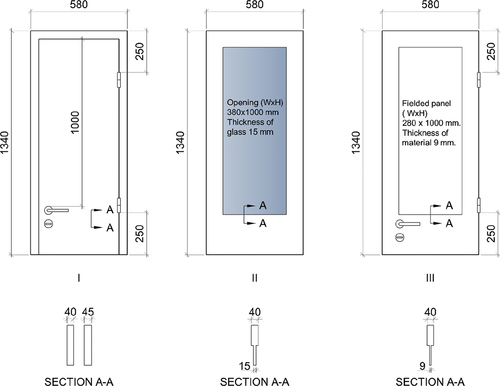
Four different methods for fastening of fire-resistant glass were tested, as shown in . The methods were chosen to cover differences in the available space in the rebate and whether the original glass was mounted on the stairwell side or on the apartment side of the door. A 15 mm intumescent strip was mounted on all four sides around the glass, and a 9 mm silicone glazing gasket was placed close to the rebate on all four sides to hold the glass in place. Setting blocks of hardwood for glass were placed on all four corners around the glass (corresponding to the steel angles). The glass was fastened either with 15 × 15 mm steel angles () or with a 30 mm steel frame (). shows photos with details of the different mounting methods.
Figure 3. Mounting of fire-resistant glass inside the rebate on the stairwell side (a) of the door or (b) on the apartment side of the door, using steel angles (test 03A and 04A). (c) shows mounting of fire-resistant glass inside the rebate with steel frame on the apartment side of the door (test 03B). (d) shows mounting of fire-resistant glass outside the rebate with steel frame (test 04B).
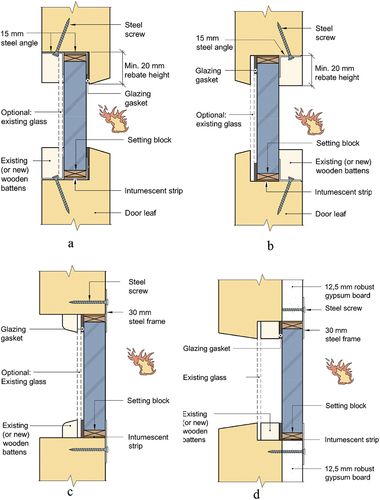
Figure 4. (A) shows a detail of mounting of fire-resistant glass with steel angles and (b) a detail of mounting of 30 mm steel frame.

lists the eight different test setups, describing the thickness of door leaf, the direction of the door swing and whether a frame was used, fire-resistant glass, fielded panel, intumescent strip and silicone gasket. The doors with a frame were swinging in towards the furnace.
Table 1. Summary of the design of the different door configurations used in the test series.
2.2. Fire testing setup and experimental procedure
The four fire tests were performed in a fire resistance furnace with internal chamber dimensions of 1550 × 1550 × 1550 mm, see . The furnace was fuelled with a premixture of propane gas and air, with three gas burners embedded in the sides of the chamber. The fire exposure followed the standard time temperature curve described in EN 1363–1 (Standard Norge Citation2020). This curve represents a model of a fully developed fire in a fire compartment and is used to classify and demonstrate fire resistance in standardised fire tests. The pressure inside the furnace was set to achieve a neutral pressure plane 500 mm above the notable floor level. The pressure was calculated in accordance with EN 1363–1.
During the test, the doors were continuously evaluated against the requirements stated in section 2.3 by measuring the unexposed surface temperature, looking for gaps in the construction and potential hotspots. When a gap or a hotspot is observed, a gauge or cotton wool pad is applied to the area to confirm the visual observation. The procedure is described in EN 1363–1 (Standard Norge Citation2020).
The duration of the tests was selected based on the desire to upgrade the doors to a fire resistance of up to 30 minutes. Test 01A and 01B lasted for 42 minutes because it was desired to see if the thickness of the door leaf (45 and 40 mm) could withstand 30 minutes of fire with a good safety margin. Test 02A and 02B lasted for 39 minutes because it was desired to see if the fielded panel upgraded with 12.5 mm robust gypsum board type R could withstand 30 minutes of fire with a good safety margin. Test 03A and 03B lasted for 30 minutes because test 03A had criteria failure after 29 minutes. Test 04A lasted for 30 minutes because it had criteria failure after 29 minutes. Test 04B lasted for 33 minutes. When the test time was over, the test specimen was lifted out from the furnace, and any burning material was extinguished with water.
2.3. Instrumentation
Unexposed surface thermocouples (TC), as described in EN 1363–1 (Standard Norge Citation2020) were placed on the unexposed side for the recording of temperature. and shows the location of the thermocouples.
Figure 6. Photo showing positioning of thermocouples on the unexposed side of test specimens 04A and 04B.
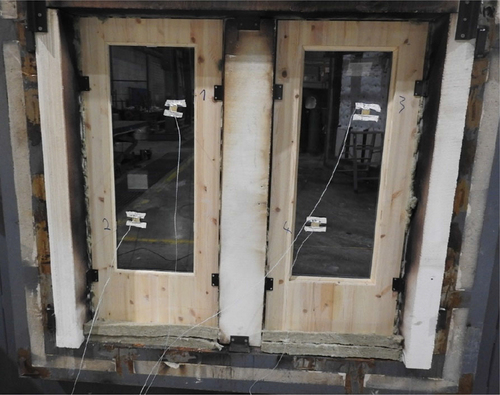
Table 2. Positioning of thermocouples (TC) on the unexposed side of the test specimens, where x = 0 (width), y = 0 (height) marks the bottom left corner of the element as viewed from the unexposed side.
2.4. Acceptance criteria and test observations
During the test series, the test specimen was subjected to a standardised time/temperature curve as described in EN 1363–1 (Standard Norge Citation2020). During the fire test, the door was checked against the performance criteria stated in EN 1363–1 (Standard Norge Citation2020) for its properties (or ability to maintain its separating function) in respect to integrity and insulation.
The integrity criteria are the doorsets ability to maintain its separating function during the test without causing ignition of a cotton wool pad applied for a maximum of 30 seconds above a hotspot, permitting the penetration of a gap gauge through the doorset into the furnace, and resulting in sustained flaming for ten seconds or longer.
The insulation criteria are the doorsets ability to maintain its separating function during the test without developing temperatures on its unexposed surface which increase the average temperature above the initial average temperature by more than 140°C, or increase at any location above the initial average temperature by more than 180°C.
3. Test results and observations
The doorsets described in were tested at RISE Fire Research facility in 2021. A total of eight different configurations were evaluated against the acceptance criteria stated in section 2.3 during the test.
3.1. Integrity and insulation
shows a summary of the test results with completed minutes without criteria failure in regard to integrity and insulation, together with the maximum temperature rise during the test. shows the results of the temperature increase on the unexposed side during the tests.
Figure 7. The temperature measurements [°C] as a function of time [minutes] for test specimens (a): 01A (TC1) and 01B (TC2), (b): 02A (TC1-TC2) and 02B (TC3-TC4), (c): 03A (TC1-TC2) and 03B (TC3-TC4), (d): 04A (TC1-TC2) and 04B (TC3-TC4).
![Figure 7. The temperature measurements [°C] as a function of time [minutes] for test specimens (a): 01A (TC1) and 01B (TC2), (b): 02A (TC1-TC2) and 02B (TC3-TC4), (c): 03A (TC1-TC2) and 03B (TC3-TC4), (d): 04A (TC1-TC2) and 04B (TC3-TC4).](/cms/asset/d16efa11-ee97-4646-975b-724e521c8888/uarc_a_2214991_f0007_oc.jpg)
Table 3. Summary of test results measured against the integrity and insulation criteria.
shows that all configurations except 03A and 04A passed the integrity acceptance criteria for at least 30 minutes. Configuration 03A failed the integrity criteria because the cotton wool pad ignited after 29.5 minutes at the connection between the glass and door leaf at mid-height, see . Configuration 04A failed the integrity criteria due to a sustained flame after 29 minutes at the connection between the glass and door leaf at mid-height, see . and show that all configurations except 04A passed the insulation acceptance criteria for at least 30 minutes. Configuration 04A failed the insulation criteria due to an increase above the initial average temperature in TC2 by more than 180°C after 29 minutes. also shows that of the four different fastening methods for the fire-resistant glass, configuration 04B lasted the longest, with 33 minutes.
3.2. Smoke seals
The effect of the smoke seals around the door frame was registered visually during the testing. In test 01A and 01B, the cold smoke seal in silicone had an effect on stopping the smoke during the first minutes of the test. Smoke was observed between the door leaf and the door frame as the pressure built up inside the furnace. In test 01A, 01B and 02B the intumescent strip expanded on heat and the smoke spread was significantly reduced after a few minutes of test duration. When examining the test specimens after the testing was completed, we could see that the intumescent strip had expanded.
4. Discussion and experimental findings
4.1. Upgrading of fire resistance
The following assumptions form the basis for the use of the test results:
Doors used in fire testing were 40 mm thick laminated wood and was chosen due to financial limitations. To upgrade, the solid wood of the original door must be at least 40 mm thick, most apartment doors meet this requirement.
Since each door to be upgraded is unique in age, thickness, type of wood, moisture content, etc., there is uncertainty about the actual fire resistance obtained after upgrading. For non-standardised material, this is an uncertainty we must accept. 30 minutes is normally enough time for evacuation and rescue in residential buildings. In Norwegian cities, the fire brigade is required to have a maximum response time of 10-20 minutes (og beredskapsdepartementet Citation2022).
Our tests have shown that it is possible to upgrade the fire resistance of timber doors for up to 30 minutes, using retrofit materials to improve the doors’ integrity and insulating properties. The acceptance criteria given in section 2.3 was met in all tests except for the cotton wool test (29 minutes in test 03A) and sustained flaming and insulation (29 minutes in test 04A). The main findings from the fire tests are:
Glass shall have a minimum fire-resistance of 30 minutes (integrity and insulation) and be securely fastened with steel frames or steel angles using one of the fastening methods described in .
Thinner parts like fielded timber panels shall be upgraded with stone wool and 12.5 mm robust gypsum boards type R as described in section 2.1.
Visual observations indicate that cold smoke seals in silicone and intumescent strips around the door frame are an efficient measure for stopping cold and hot smoke.
The reasons for not passing the acceptance criteria for the cotton wool test (29 minutes in test 03A) and sustained flaming and insulation (29 minutes in test 04A) are unknown. Fire testing is not an exact science, and small deviations in the materials (like knot holes in the wood) or in the mounting of for instance steel angles or intumescent strips around the fire-resistant glass can lead to different outcomes in the same test. Test 04B lasted for 33 minutes, and this indicates that it might be the most robust fastening method of fire-resistant glass of the four methods described in . Tests 01A/01B and 02A/02B lasted for nearly 40 minutes or more. This indicates that 40 mm of laminated wood and the upgrading of thin timber panels using stone wool and robust gypsum boards type R are robust solutions with good safety margins.
This paper presents modifications to the door itself and possible solutions for mounting of fire-resistant glass, protective boards and smoke seals. Hardware such as door closers, door fittings, hinges and handles, and the transition between the door frame and wall is outside the scope of the test assignment.
Fire door is only one of many building parts that contributes to fire safety in a building. When securing an escape route, the building must be seen as a whole, and compensatory solutions should be considered by the fire safety engineer.
4.2. Limitations of application
The intention was to follow the test method and acceptance criteria in EN 1363–1 (Standard Norge Citation2020) and EN 1634–1 (Standard Citation2018) where possible. During a standardised test, it is stated that a test specimen of a “representative” size should be tested. A historical type of door would be destroyed during the test, and the following test would not be representative. Therefore, the doors used in intermediate-scale fire testing were new doors made of laminated wood, not original solid wood. However, the charring rate for the two are similar; 0.65 mm/min for solid wood and 0.5–0.65 mm/min for laminated wood (Standard Norge Citation2010). The difference is considered not to have a significant impact on the result.
The tests 03A/03B and 04A/04B was performed without the door frame, e.g. only the door leaf mounted directly into the supporting structure. Since these tests had focus on different fastening methods for fire-resistant glass it was not considered necessary to include the door frame.
The doors used in intermediate-scale fire testing measured 0.58 m × 1.34 m, whereas the standard door dimension is often around 0.9 m × 2.0 m. Higher doors are more subjected to bending during heat exposure, which may not have been reflected in the test result. This is an uncertainty we must accept. The project`s financial limitations did only allow for intermediate-scale testing instead of full-scale.
The distance from the edge of the door leaf to the glass window opening must give a stable frame and must be considered in each case. Fire-resistant glass is usually thicker than normal glass and, therefore, heavier. The maximum size must be considered in each case. The glass used in the fire testing had an area of 0.4 m2 and weighed 12.6 kg.
Upgrading with a 12.5 mm robust gypsum boards type R will also give additional weight to the door, and the condition of the hinges must be considered in each case. Adding an extra hinge to take up the additional load may be a solution.
Some doors to be upgraded may have open cut-outs like letter holes. These must be sealed to prevent fire spread.
4.3. Preservation of aesthetic and historical values: evaluation of the result
Compromises are inevitable when architectural heritage values and fire safety requirements are to be reconciled. However, past technical measures carried out on doors vary in quality and standard. Sometimes, unsuitable changes cause the original architectural features to be lost in the process. The main goal of the project is to ensure that invasive measures carried out on the original doors achieve two goals: 1) perform satisfactorily as fire protection, and 2) interfere as little as possible with the original form and material.
Old stairwells are often given the status of what is known as “half-common” areas in cultural heritage management plans. The stairwell side of a door is given a higher value and is therefore more important to preserve than the apartment side. In this test project, the preservation of the stairwell side of the door was prioritised.
A focus in the elaboration of technical solutions in the project has been the preservation of the glass openings. This is because the visual connection between the apartment and the stairwell is often given a high aesthetic and architectural value in cultural heritage evaluations. By adding or replacing fire-rated glass, it is possible to preserve both the original light openings in the doors and the light transmitted through the stairwell.
In order to preserve the glass openings and meet the diversity of the original doors’ construction, four different solutions were presented and tested. With three of these solutions, the interventions were performed on the apartment side. Two of the solutions for glass mounting entail sacrificing parts of the original wooden material by milling out a broader rebate in the glass opening to ensure that the new glass is held in place.
Fire-resistant glass is much thicker than the original glass panes and completely flat. When possible, the original glass should be kept on the stairwell side and outside of the fire-resistant glass. This is because the flatness of modern float glass — with its directional, planar reflections — can be somewhat visually disturbing; this new glass may stand out in the old stairwell interior.
The gypsum board solution is suggested for the lower part of the door on the inside, as it will not be visible from the stairwell side. Additionally, the doors’ original features can be preserved behind the board. This solution can be a good solution due to its high degree of reversibility.
Fire-rated glass and gypsum board mountings will, in some cases, lead to the alteration or removal of elaborate mouldings. If the mouldings are loosened, they can be reused on the outside of the gypsum board for both aesthetic and preservation purposes.
The application of fire-rated glass and gypsum boards represents an alternative to the replacement of the original doors. Fire tests have so far been executed solely on new intermediate-scale doors, so a final evaluation of the preservation of aesthetic and historic values remains. However, the tests performed suggested that these solutions function well as fire protection. The unavoidable loss of some original architectural features will still be an issue, but at the very least, the intended fire protection effect will be achieved.
5. Conclusion
The research work in this paper investigates (1) weather fire-resistant glass, gypsum boards and smoke seals are effective retrofit materials for original timber panelled stairwell doors, and how to fasten them to obtain a fire resistance of up to 30 minutes, and (2) that the solutions presented enables the preservation of the original doors’ architectural design, their historical values and aesthetic character. The upgrading methods have aimed to be as little intrusive and destructive as possible.
Intermediate scale tests were carried out in an indicative fire resistance test furnace using different door configurations. The tests lasted between 30 minutes and 42 minutes, with a thermal exposure from the standard fire curve described in EN 1363–1. The results from the tests showed that goal (1) was met: It is possible to upgrade the fire resistance of timber doors for up to 30 minutes, using retrofit materials to improve the doors’ integrity and insulating properties during fire exposure. 40 mm thick laminated wood can withstand at least 30 minutes of fire, thin timber panels can be upgraded using stone wool and robust gypsum board type R, and fire-resistant glass can be mounted on the inside of the original glass using different fastening methods as shown in . As far as the authors know, these fastening methods have never been tested and documented before, which indicates that this is new knowledge. Visual observations indicate that sealing strips inside the door leaf are effective for stopping cold and hot smoke.
Goal (2) was also met: The solutions presented enables the preservation of the original doors’ architectural design, their historical values and aesthetic character. The solutions presented prioritise the preservation of the stairwell side of the door unchanged and the preservation of light openings and transmitted light in the stairwell. The use of gypsum boards on the inside of the doors can be a minimally invasive, reversible approach.
While the aesthetically considerate design will greatly reduce the impact on the doors, this must not compromise the effectiveness of passive fire protection. How invasive the solutions will be in terms of the original door material will vary from door to door.
This paper has shown effective retrofit methods for upgrading of fire resistance to wooden cultural heritage escape route doors and will hopefully contribute to both preservation and improved fire safety. Limitations of the study is that testing was performed on new medium scale doors of laminated wood. We recommend that further research be carried out involving timber doors in a large-scale fire test furnace since larger doors are more subject to bending during heat exposure. Also, further research should include testing original doors of original material to see if the solutions described in this study are working as intended.
Acknowledgments
This research is with the support from the Fire Research and Innovation Centre (FRIC) with partners. This research is a part of FRIC work package 3.1.5 Solutions for protection of cultural heritage escape route doors (2021-2022).
Disclosure statement
No potential conflict of interest was reported by the authors.
Additional information
Funding
References
- Andersson, E. 2005. ‘Brannteknisk Prøving Av En Original Trapperomsdør Med Trådglass Fra En 1890-Gård/Eldre Murgård i Henhold Til NS 3907’. Test report. Trondheim, Norway: SINTEF NBL.
- Bergius, M. 2022. ‘Small Scale Test of Miniature Wooden Doors. Non-Standardized Test’. Test report. Trondheim, Norway: Fire research and innovation center (FRIC).
- Direktoratet for byggkvalitet. 2017. ‘Byggteknisk forskrift TEK17’. Direktoratet for byggkvalitet. https://dibk.no/regelverk/byggteknisk-forskrift-tek17/.
- Dyrseth, G. R. 2014. ‘Oppgradering Av Brannsikkerheten i Eldre Murgårder.’ Master thesis, Trondheim: Norges teknisk-naturvitenskapelige universitet.
- English Heritage. 1997. Timber Panelled Doors and Fire - Upgrading the Fire Resistance Performance of Timber Panelled Doors and Frames. London, United Kingdom: English Heritage.
- Haukø, A. -M., and B. Wedvik 2021. ‘Upgrading Heritage Escape Route Doors – Mounting of Glass, Protective Boards and Sealing Lists.’ Research report. Trondheim/Oslo, Norway: Fire research and innovation center (FRIC).
- Historic England. 2021. Guide to the Fire Resistance of Historic Timber Panel Doors. Historic England 1: 36–43.
- Justis- og beredskapsdepartementet. 2022. Forskrift Om Organisering, Bemanning Og Utrustning Av Brann- Og Redningsvesen Og Nødmeldesentralene (Brann- Og Redningsvesenforskriften). Justis- og beredskapsdepartementet FOR-2021-09-15-2755.
- Korsaksel, A. 2009. Må Dørene Skiftes Ut : Praktisk Bygningsvern - Del 7. Fremtid for Fortiden, Vol Innovation 1: 20–23.
- Olofsson, R. 2019. Brannteknisk Prøving Av Tofløya Tredør i Vegg Av Gassbetong. Trondheim, Norway: RISE Fire Research.
- Oslo kommune Brann- og redningsetaten. 2007. ‘Prosjekt Brannsikker Bygård. Sluttrapport.’ Oslo.
- Oslo kommune Brann- og redningsetaten. 2015. ‘Brannsikring Eldre Murgårder’. Oslo: Oslo kommune Brann- og redningsetaten.
- Oslo kommune by Byantikvaren and Brann- og redningsetaten. 2015. Brannteknisk forbedring av bevaringsverdige trapperomsdører. Oslo.
- Popescu, C. -M., and A. Pfriem. 2020. Treatments and Modification to Improve the Reaction to Fire of Wood and Wood Based Products—An Overview. Fire and Materials 44 (1):100–11. doi:10.1002/fam.2779.
- Røssland, E., and K. Vik 2006. ‘Føringer for å Anslå Brannmotstand På Gamle Trefyllingsdører’. Bachelor thesis, Haugesund: Høgskolen Stord/Haugesund.
- SINTEF. 2016. SINTEF Byggforskserien 734.503 Brannteknisk Forbedring Av Gamle Trefyllingsdører. Oslo, Norway: SINTEF.
- Standard Norge. 2010. NS-EN 1995-1-2:2004+NA:2010 Eurocode 5: Design of Timber Structures - Part 1-2: General - Structural Fire Design. Oslo, Norway: Standard Norge.
- Standard Norge. 2018. ‘NS-EN 1634-1: 2014+A1: 2018 Fire Resistance and Smoke Control Tests for Door and Shutter Assemblies, Openable Windows and Elements of Building Hardware - Part 1: Fire Resistance Test for Door and Shutter Assemblies and Openable Windows’. Oslo, Norway: Standard Norge.
- Standard Norge. 2020. ‘EN 1363-1: 2020 Fire Resistance Tests — Part 1: General Requirements’. Oslo, Norway: Standard Norge.
- Stenstad, V. 1983. ‘Eldre Murgårdar Og Brann: Ei Undersøking Av Murgårdar Bygd i Perioden ca. 1870-1940, Spesielt Med Tanke På Branntekniske Forhold Og Brannsikring.’ PhD thesis, Trondheim: Institutt for husbyggingsteknikk, Norges tekniske høgskole, Universitetet i Trondheim.
- Walmerdahl, P., G. C, and T. K. 2000. Appendicitis and chronic typhilitis in an immigrant from Southeast Asia. International Journal of Infectious Diseases: IJID: Official Publication of the International Society for Infectious Diseases 4 (4):219–21. doi:10.1016/s1201-9712(00)90113-9.
- Wedvik, B. 2018. Brannsikring Av Trapperomsdører i Gamle Bygårder. Hvordan Påvirker Det Kulturminneverdien? Meddelelser Om Konservering 2018 1: 13.
- Zahmatkesh, F., and A. Memari. 2017. Review of Conventional and Innovative Technologies for Fire Retrofitting of Existing Buildings. Open Journal of Civil Engineering 7 (June):222–44. doi:10.4236/ojce.2017.72014.

